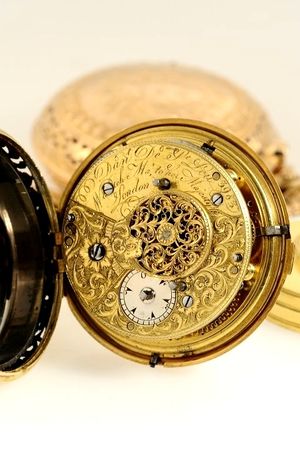De St Leu, Daniel/en: Unterschied zwischen den Versionen
Keine Bearbeitungszusammenfassung |
Keine Bearbeitungszusammenfassung |
||
| (3 dazwischenliegende Versionen desselben Benutzers werden nicht angezeigt) | |||
| Zeile 1: | Zeile 1: | ||
'''De St Leu, Daniel''' | '''De St Leu, Daniel''' | ||
[[Datei:Daniel De Saint Leu, London, Werk Nr. 3983, Geh. Nr. 3983, circa 1794 (1).jpg|thumb|Taschenuhr für den Osmanischen Markt von Daniel De St Leu]] | |||
[[Datei:Daniel De Saint Leu, London, Werk Nr. 3983, Geh. Nr. 3983, circa 1794 (9).jpg|thumb|Taschenuhrwerk von Daniel De St Leu]] | |||
Daniel de St. Leu originally came from Geneva and worked from 1753 to 1797; he created some of the most beautiful and intricate watches of the eighteenth century. In 1765 he was appointed watchmaker to Queen Charlotte, wife of King George III - the fact that all of de St. Leu's watches after this year are either signed 'Sevt. to her Majesty', or 'Watch Maker to her Majesty' is proof that he held this title for the rest of his life. | Daniel de St. Leu originally came from Geneva and worked from 1753 to 1797; he created some of the most beautiful and intricate watches of the eighteenth century. In 1765 he was appointed watchmaker to Queen Charlotte, wife of King George III - the fact that all of de St. Leu's watches after this year are either signed 'Sevt. to her Majesty', or 'Watch Maker to her Majesty' is proof that he held this title for the rest of his life. | ||
De St. Leu was specialized in the production of watches for the wealthy Ottoman market, where the clientele wanted their watches to be pieces of jewellery, often in lavish gold cases with elaborate decoration and set with precious stones. In the 18th century, English watches were very much in demand on the Ottoman market and exported in great numbers from England. R. Rolt states in 'A New Dictionary of Trade and Commerce', 1756, that "Great quantities of watches are exported to Asia, particularly to Turkey; where they serve more for ornaments like pictures in rooms, than for use in pockets." Daniel de St. Leu created movements of superior quality and put them in extravagant cases - the perfect timepieces for the Ottoman market. | De St. Leu was specialized in the production of watches for the wealthy Ottoman market, where the clientele wanted their watches to be pieces of jewellery, often in lavish gold cases with elaborate decoration and set with precious stones. In the 18th century, English watches were very much in demand on the Ottoman market and exported in great numbers from England. R. Rolt states in 'A New Dictionary of Trade and Commerce', 1756, that "Great quantities of watches are exported to Asia, particularly to Turkey; where they serve more for ornaments like pictures in rooms, than for use in pockets." Daniel de St. Leu created movements of superior quality and put them in extravagant cases - the perfect timepieces for the Ottoman market. | ||
== Further information == | |||
*[[:Category:Picture gallery watch models De St Leu, Daniel|Picture gallery watch models De St Leu, Daniel]] | |||
*[[:Category:Picture gallery movements De St Leu, Daniel|Picture gallery movements De St Leu, Daniel]] | |||
== Literature == | |||
*[[Watchmakers & Clockmakers of the World]]; Autor: Baillie, G. H.; ISBN 140679113X, page | |||
[[Category:Biography]] | |||
[[de:De St Leu, Daniel/de]] | |||
[[en:De St Leu, Daniel/en]] | |||
Aktuelle Version vom 14. Juni 2015, 01:02 Uhr
De St Leu, Daniel


Daniel de St. Leu originally came from Geneva and worked from 1753 to 1797; he created some of the most beautiful and intricate watches of the eighteenth century. In 1765 he was appointed watchmaker to Queen Charlotte, wife of King George III - the fact that all of de St. Leu's watches after this year are either signed 'Sevt. to her Majesty', or 'Watch Maker to her Majesty' is proof that he held this title for the rest of his life.
De St. Leu was specialized in the production of watches for the wealthy Ottoman market, where the clientele wanted their watches to be pieces of jewellery, often in lavish gold cases with elaborate decoration and set with precious stones. In the 18th century, English watches were very much in demand on the Ottoman market and exported in great numbers from England. R. Rolt states in 'A New Dictionary of Trade and Commerce', 1756, that "Great quantities of watches are exported to Asia, particularly to Turkey; where they serve more for ornaments like pictures in rooms, than for use in pockets." Daniel de St. Leu created movements of superior quality and put them in extravagant cases - the perfect timepieces for the Ottoman market.
Further information
Literature
- Watchmakers & Clockmakers of the World; Autor: Baillie, G. H.; ISBN 140679113X, page